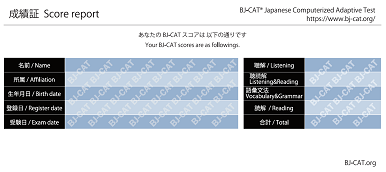About BJ-CAT scores
BJ-CAT scores and The Level of Business Japanese corresponding to the score of BJ-CAT
| BJ-CAT | Proficiency Level | JLPT | |
|---|---|---|---|
| 400-300 | BJ1 | In every kind of business situations, he/she can communicate in Japanese adequately. | Superior level |
| 299-200 | BJ2 | In some business situations, he/she can communicate in Japanese fairly well. | N1 |
| 249-200 | BJ3 | In some business situations, he/she can communicate in Japanese relatively well. | N2ーN1 |
| 199-100 | BJ4 | In some business situations, he/she can communicate in Japanese a little. | N3ーN2 |
| 99-0 | BJ5 | In some business situations, he/she can communicate in Japanese only in a limited manner. | N5ーN4 |
About Item Response Theory (IRT)
In BJ-CAT Business Japanese test, the Item Response Theory (IRT) is used to assess the examinee's Business Japanese skills.
BJ-CAT is unlike other tests that assess based on unadjusted scores. BJ-CAT takes the difficulty of the item (question) into consideration, and assesses the examinee's ability based on the probability theory.
About Conputer Adaptive Test (CAT)
CAT is a test that uses questions which are suitable for each examinee. The questions are selected by a computer, based on each examinee's ability. CAT uses IRT and assesses the ability of an examinee every time he/she answers.
Therefore, CAT and IRT have the following advantages compared to tests based on unadjusted scores.
- Suitable questions for a wide range of examinees
- Can calculate scores with few questions (=shorter time)
- Can calculate scores with equal standards regardless of when the test is taken
- Can know scores as the test ends
Score report (Grade report)
Students who have taken the test can dowload their score report as a PDF file. The students' name, group, birthdate, register date, test date, scores for each section, and the score convert table will be printed on it.

Diagram 1: Example of a score report
